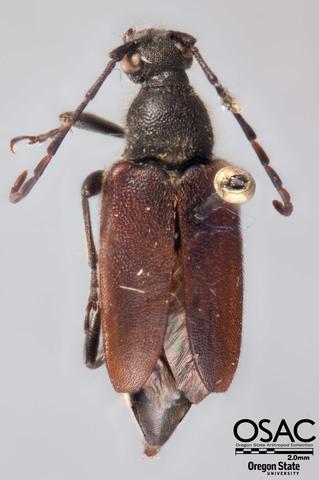You are here
Lepturinae
Brachyleptura Casey, 1913
Nomenclature
-
Subfamily: LepturinaeTribe: Lepturini
SUMMARY
Seven species of Brachyleptura may be recognized, all of which exist in North America. Two species occur in the Pacific Northwest.
Brachyleptura Casey, 1913:247
Toxoleptura Miroshnikov, 1998:411
dehiscens (LeConte, 1859:89)
vexatrix (Mannerheim, 1853:250)
quadrillum LeConte, 1859:88
convolvens Casey, 1913:250
Diagnosis. Brachyleptura can be distinguished by the strongly convex, seemingly "inflated" pronotum, the narrow intercoxal process of the prosternum, and elytra which are truncate and dehiscent (diverging) at the tips.
Remarks on Classfication
Miroshnikov (1998) proposed that the species B. vexatrix and B. pernigra are easily separated as a new genus, Toxoleptura Miroshnikov 1998:411, based on the peculiar structure of the male genitalia of both species, as well as by the placement of the antennal insertions. Monné and Bezark (2013) do not accept Toxoleptura as valid. However, the figure below (taken without permission) from Miroshnikov (1998, p. 415) demonstrates the clear relationship between Brachyleptura (Toxoleptura) vexatrix and B. (Toxoleptura) pernigra relative to B. rubrica.
Key to PNW species.
(1.) Elytral apices with inner angle rounded.
Antennae with outer segments expanded apically. .... dehiscens
(1') Elytral apices with inner angle acute.
Antennae slender, outer segments not expanded. .... vexatrix
Brachyleptura dehiscens is brown- to reddish brown with the males being smaller and more lightly colored than the females. The species can be distinguished from B. vexatrix with the following two characters: elytra truncate with the interior apical angles rounded, and antennae with the 5 outer segments expanded apically, (almost sub-serrate). B. dehiscens ranges from British Columbia to the Sierra Nevadas of northern California. Its host plant is known to be Pinus and has been reported on the flowers of Daucus , Spiraea, Angelica, Ceanothus, and Chrysolepis from July to August (Linsley and Chemsak, 1976: 171). The latest specimen in the Oregon State Arthropod Collection (OSAC) was taken on August 31, 1963 at 3000 ft. elevation near the Metolius River in Jefferson Co., Oregon.
B. dehiscens is apparently not commonly collected. OSAC only holds 26 specimens of this species, compared with several hundred specimens of B. vexatrix. Of dehiscens, a small series (3 specimens) is present from the HJ Andrews Experimental Forest in Lane Co., Oregon, dating from August 1st -9th of 1973. These are attributed to the IBP Biome Survey of WP Nage and G Daterman, and were collected using a 'rotary net trap' at Clearcut Area #L107.

Above. B. dehiscens, female.
B. vexatrix can be distinguished by its narrower antennae that are not serrate or sub-serrate. The inner angles of the elytral apices are acute in vexatrix. North of the Siskiyous, the elytra of this species are generally almost entirely black, and occassionaly with yellow spots. From Northern California southward into the Sierra Nevadas the elytra become more prominently yellow with black spots. This latter population was described as Judolia convolvens by Casey (1913), who commented that it should be easily distinguishable from Mannerheim's vexatrix, which was described from the Kenai Peninsula of Alaska: "The two are very different, as may be seen at once on reading Mannerheim's ample description" (Casey, 1913: 251). Casey's convolvens holotype is held at the Smithsonian Museum in Washington, DC.

Above. B. vexatrix, male.
Works Cited
- Casey, T. L. 1913. Further studies amongst the American Longicornia. Memoirs on the Coleoptera, 4:193-388. <Link to Biodiversity Heritage Library> <PDF>
- LeConte, J. L. 1859. Catalogue of the Coleoptera of Fort Tejon, California. Proceedings of the Academy of Natural Sciences of Philadelphia, 11:69-90. <Link to BHL>
- Linsley, E.G. and J.A. Chemsak. 1976. Cerambycidae of North America. Part VI, No.2. Taxonomy and Classification of the Subfamily Lepturinae. University of California Publications in Entomology 80, 186 pp.
- Mannerheim, C. G. von. 1853. Dritter Nachtrag zur Käfer-Fauna der Nord-Amerikanischen Länder des Russischen Reiches. Bull. Soc. Imp. Natur. Moscou, 26(2):96-273.
- Miroshnikov, A. I., 1998: A new classification of longicorn beetles of the Anoplodera complex, tribe Lepturini Coleoptera, Cerambycidae of Holarctic fauna. I. Entomologicheskoe Obozrenie 77(2): 384-420. [English Translation: Entomological Reivew, Vol. 78, No. 4, 1998, pp. 437--465.]
- Bezark, L. G. and M. A. Monné. 2013. Checklist of the Oxypeltidae, Vesperidae, Disteniidae and Cerambycidae, (Coleoptera) of the Western Hemisphere. Available from: plant.cdfa.ca.gov/byciddb/documents.html (Accessed on 4 July 2013).



